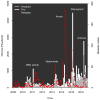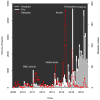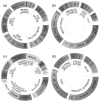Facebook and Twitter vaccine sentiment in response to measles outbreaks
- PMID: 29148313
- PMCID: PMC5930144
- DOI: 10.1177/1460458217740723
Facebook and Twitter vaccine sentiment in response to measles outbreaks
Abstract
Social media posts regarding measles vaccination were classified as pro-vaccination, expressing vaccine hesitancy, uncertain, or irrelevant. Spearman correlations with Centers for Disease Control and Prevention-reported measles cases and differenced smoothed cumulative case counts over this period were reported (using time series bootstrap confidence intervals). A total of 58,078 Facebook posts and 82,993 tweets were identified from 4 January 2009 to 27 August 2016. Pro-vaccination posts were correlated with the US weekly reported cases (Facebook: Spearman correlation 0.22 (95% confidence interval: 0.09 to 0.34), Twitter: 0.21 (95% confidence interval: 0.06 to 0.34)). Vaccine-hesitant posts, however, were uncorrelated with measles cases in the United States (Facebook: 0.01 (95% confidence interval: -0.13 to 0.14), Twitter: 0.0011 (95% confidence interval: -0.12 to 0.12)). These findings may result from more consistent social media engagement by individuals expressing vaccine hesitancy, contrasted with media- or event-driven episodic interest on the part of individuals favoring current policy.
Keywords: measles; patient compliance; social media; treatment refusal; vaccination.
Conflict of interest statement
Figures




References
-
- Henderson DA, Dunston FJ, Fedson DS, et al. The measles epidemic: The problems, barriers, and recommendations. JAMA. 1991;266:1547–1552. - PubMed
-
- Sabella C. Measles: not just a childhood rash. Clevel Clin J Medicine. 2010;77:207–213. - PubMed
-
- Perry RT, Halsey NA. The clinical significance of measles: a review. J Infect Dis. 2004;189(Suppl 1):S4–S16. - PubMed
-
- Moss WJ, Griffin DE. Measles. Lancet. 2012;379:153–164. - PubMed
-
- Committee on Infectious Diseases. Red Book 2015. Report of the Committee on Infectious Diseases. American Academy of Pediatrics; 2015.
Publication types
MeSH terms
Grants and funding
LinkOut - more resources
Full Text Sources
Other Literature Sources
Medical

